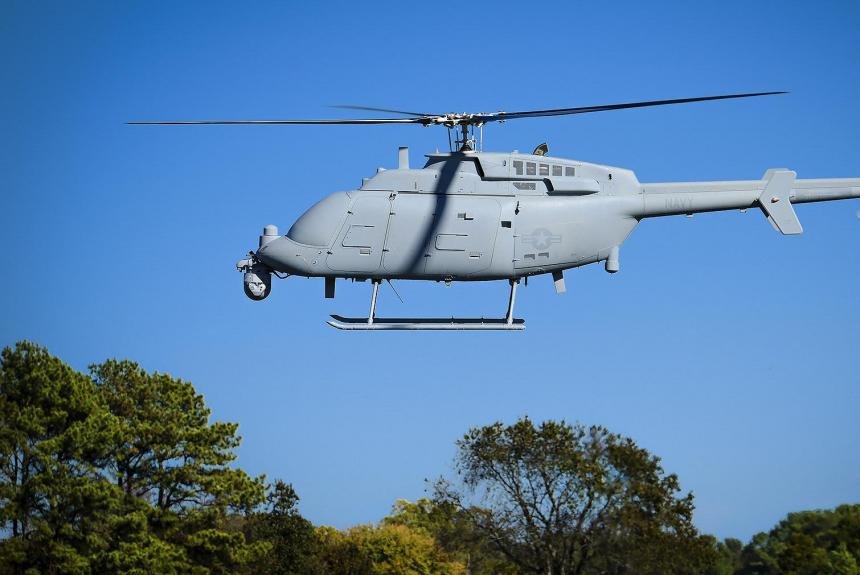US Navy's Fire Scout unmanned helicopter achieves initial operational capability
JULY 9, 2019
By Allen Cone

The MQ-8C Fire Scout unmanned helicopter conducts a flight test at Naval Air Patuxent River Webster Field Annex in Saint Inigoes, Md. Photo courtesy U.S. Navy
July 9 (UPI) -- The U.S. Navy's MQ-8C Fire Scout unmanned helicopter has reached initial operational capability, paving the way for fleet operations and training.
On June 28, the sea-based, vertical lift drone manufactured by Northrop Grumman was declared to achieve operational capability, the Navy said Monday.
The aircraft is designed to provide reconnaissance, situational awareness and precision targeting support for ground, air and sea forces.
"This milestone is a culmination of several years of hard work and dedication from our joint government and industry team," Capt. Eric Soderberg, Fire Scout program manager, said. "We are excited to get this enhanced capability out to the fleet."
The MQ-8C is an endurance and payload upgrade to the smaller MQ-8B.
The variant can fly up to 12 hours on station depending on payload. It incorporates the commercial Bell 407 airframe, which numbers more than 1,600 Bell with more than 4.4 million flight hours.
The MQ-8C has flown more than 1,500 test hours, including more than 700 sorties. It is 34.7 feet long and 8.7 feet wide.
The MQ-8C Fire Scout system flew for the first time off the USS Jason Dunham, a guided-missile destroyer off the Virginia coast near Norfolk on Dec. 23, 2014.
Northrop Grumman is contracted to deliver 38 aircraft over the next few years. It is scheduled to deploy on littoral combat ships in fiscal year 2021. The smaller MQ-8B Fire Scout, which has completed more than 16,600 flight hours over 6,200 sorties, including in Afghanistan, is currently deployed on a LCS.
The drone complements the manned MH-60 helicopter by extending the range and endurance of ship-based operations. It will include upgraded radar that allows for a larger field of view and a range of digital modes, including weather detection, air-to-air targeting and a ground moving target indicator.
"Combined with the maturity of Northrop Grumman's autonomous systems architecture, Fire Scout meets customer requirements for a ship-based and land-based autonomous systems," according to Northrop Grumman. "It also has the ability to autonomously take-off and land on any aviation-capable ship and from prepared and unprepared landing zones."

 www.upi.com
www.upi.com
JULY 9, 2019
By Allen Cone
The MQ-8C Fire Scout unmanned helicopter conducts a flight test at Naval Air Patuxent River Webster Field Annex in Saint Inigoes, Md. Photo courtesy U.S. Navy
July 9 (UPI) -- The U.S. Navy's MQ-8C Fire Scout unmanned helicopter has reached initial operational capability, paving the way for fleet operations and training.
On June 28, the sea-based, vertical lift drone manufactured by Northrop Grumman was declared to achieve operational capability, the Navy said Monday.
The aircraft is designed to provide reconnaissance, situational awareness and precision targeting support for ground, air and sea forces.
"This milestone is a culmination of several years of hard work and dedication from our joint government and industry team," Capt. Eric Soderberg, Fire Scout program manager, said. "We are excited to get this enhanced capability out to the fleet."
The MQ-8C is an endurance and payload upgrade to the smaller MQ-8B.
The variant can fly up to 12 hours on station depending on payload. It incorporates the commercial Bell 407 airframe, which numbers more than 1,600 Bell with more than 4.4 million flight hours.
The MQ-8C has flown more than 1,500 test hours, including more than 700 sorties. It is 34.7 feet long and 8.7 feet wide.
The MQ-8C Fire Scout system flew for the first time off the USS Jason Dunham, a guided-missile destroyer off the Virginia coast near Norfolk on Dec. 23, 2014.
Northrop Grumman is contracted to deliver 38 aircraft over the next few years. It is scheduled to deploy on littoral combat ships in fiscal year 2021. The smaller MQ-8B Fire Scout, which has completed more than 16,600 flight hours over 6,200 sorties, including in Afghanistan, is currently deployed on a LCS.
The drone complements the manned MH-60 helicopter by extending the range and endurance of ship-based operations. It will include upgraded radar that allows for a larger field of view and a range of digital modes, including weather detection, air-to-air targeting and a ground moving target indicator.
"Combined with the maturity of Northrop Grumman's autonomous systems architecture, Fire Scout meets customer requirements for a ship-based and land-based autonomous systems," according to Northrop Grumman. "It also has the ability to autonomously take-off and land on any aviation-capable ship and from prepared and unprepared landing zones."

Navy's Fire Scout unmanned helicopter achieves initial operational capability - UPI.com
The U.S. Navy's MQ-8C Fire Scout unmanned helicopter has reached initial operational capability, paving the way for fleet operations and training.
